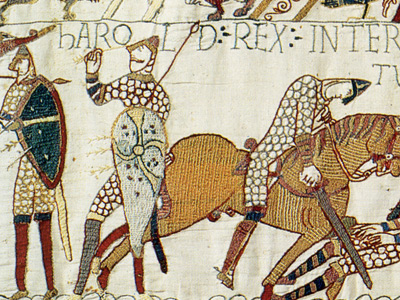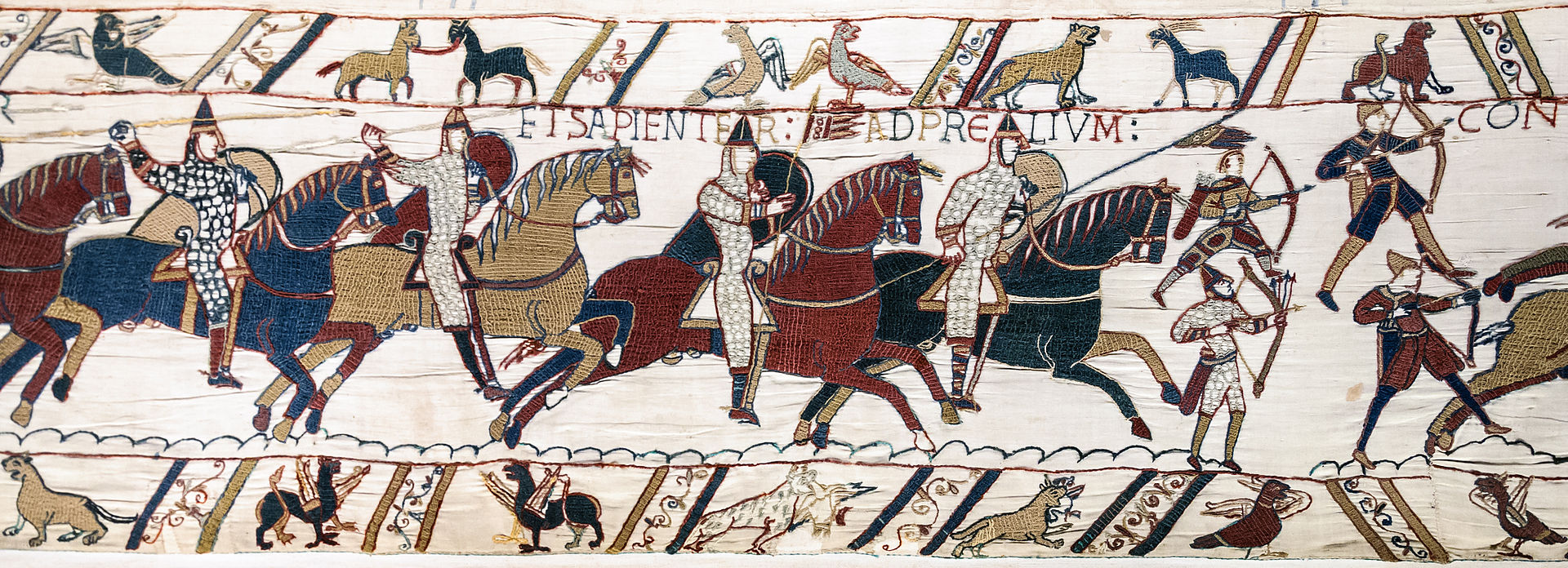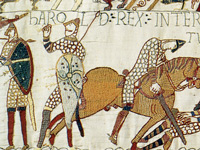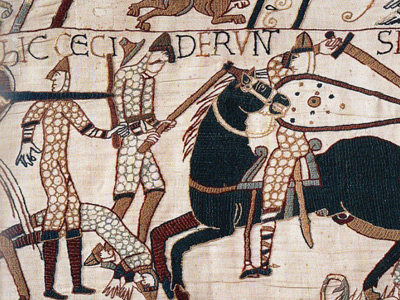Battle of Hastings (1066)

William's Preparations and Landing
William assembled a large invasion fleet and an army gathered from Normandy and the rest of France, including large contingents from Brittany and Flanders. He spent almost nine months on his preparations, as he had to construct a fleet from nothing. According to some Norman chronicles, he also secured diplomatic support, although the accuracy of the reports has been a matter of historical debate. The most famous claim is that Pope Alexander II gave a papal banner as a token of support, which only appears in William of Poitiers's account, and not in more contemporary narratives. In April 1066 Halley's Comet appeared in the sky, and was widely reported throughout Europe. Contemporary accounts connected the comet's appearance with the succession crisis in England.
William mustered his forces at Saint-Valery-sur-Somme, and was ready to cross the English Channel by about 12 August. But the crossing was delayed, either because of unfavourable weather or to avoid being intercepted by the powerful English The Kingdom of England was a sovereign state on the island of Great Britain from about 927, when it emerged from various Anglo-Saxon kingdoms, until 1 May 1707, when it united with Scotland to form the Kingdom of Great Britain. The Viking invasions of the 9th century upset the balance of power between the English kingdoms, and native Anglo-Saxon life in general. The English lands were unified in the 10th century in a reconquest completed by King Æthelstan in 927. fleet. The Normans crossed to England a few days after Harold's victory over the Norwegians, following the dispersal of Harold's naval force, and landed at Pevensey in Sussex on 28 September. A few ships were blown off course and landed at Romney, where the Normans fought the local fyrd. After landing, William's forces built a wooden castle at Hastings, from which they raided the surrounding area. More fortifications were erected at Pevensey.
The Kingdom of England was a sovereign state on the island of Great Britain from about 927, when it emerged from various Anglo-Saxon kingdoms, until 1 May 1707, when it united with Scotland to form the Kingdom of Great Britain. The Viking invasions of the 9th century upset the balance of power between the English kingdoms, and native Anglo-Saxon life in general. The English lands were unified in the 10th century in a reconquest completed by King Æthelstan in 927. fleet. The Normans crossed to England a few days after Harold's victory over the Norwegians, following the dispersal of Harold's naval force, and landed at Pevensey in Sussex on 28 September. A few ships were blown off course and landed at Romney, where the Normans fought the local fyrd. After landing, William's forces built a wooden castle at Hastings, from which they raided the surrounding area. More fortifications were erected at Pevensey.

Norman knights and archers at the Battle of Hastings depicted in the Bayeux Tapestry

Norman knights and archers at the Battle of Hastings depicted in the Bayeux Tapestry
( Click image to enlarge)
Norman forces at Hastings
The exact numbers and composition of William's force are unknown. A contemporary document claims that William had 776 ships, but this may be an inflated figure. Figures given by contemporary writers are highly exaggerated, varying from 14,000 to 150,000. Modern historians have offered a range of estimates for the size of William's forces: 7,000–8,000 men, 1,000–2,000 of them cavalry; 10,000–12,000 men; 10,000 men, 3,000 of them cavalry; or 7500 men. The army consisted of cavalry, infantry, and archers or crossbowmen, with about equal numbers of cavalry and archers and the foot soldiers equal in number to the other two types combined. Later lists of companions of William the Conqueror are extant, but most are padded with extra names; only about 35 named individuals can be reliably identified as having been with William at Hastings.
The main armour used was chainmail hauberks, usually knee-length, with slits to allow riding, some with sleeves to the elbows. Some hauberks may have been made of scales attached to a tunic, with the scales made of metal, horn or hardened leather. Headgear was usually a conical metal helmet with a band of metal extending down to protect the nose. Horsemen and infantry carried shields. The infantryman's shield was usually round and made of wood, with reinforcement of metal. Horsemen had changed to a kite-shaped shield and were usually armed with a lance. The couched lance, carried tucked against the body under the right arm, was a relatively new refinement and was probably not used at Hastings; the terrain was unfavourable for long cavalry charges. Both the infantry and cavalry usually fought with a straight sword, long and double-edged. The infantry could also use javelins and long spears. Some of the cavalry may have used a mace instead of a sword. Archers would have used a self bow or a crossbow, and most would not have had armour.
HISTORY

RESOURCES
This article uses material from the Wikipedia article "Battle of Hastings", which is released under the Creative Commons Attribution-Share-Alike License 3.0.
© Stories Preschool. All Rights Reserved.









